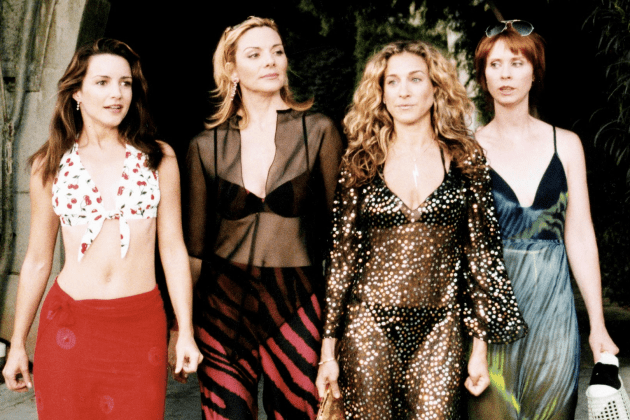‘Sex and the City’ on Netflix: What the Ultimate Period Piece Might Mean to a Gen Z Audience
- Oops!Something went wrong.Please try again later.

The “Netflix and chill” generation has just been confronted with, well, “Sex.”
“Sex and the City,” which wrapped up its six-season run on HBO in 2004, has arrived on the streaming platform, and is currently ranked at No. 7 in the Netflix Top 10. (This places it comfortably ahead of “Buying Beverly Hills” but behind “Is It Cake?” and a title Samantha Jones might appreciate, “3 Body Problem.”)
More from Variety
Netflix’s firehose of viewers represents something different for Carrie Bradshaw and the gang. Though “Sex and the City,” one of the class of early shows that led the pay-cable revolution, is utterly entwined with HBO’s brand, it’s also broken out before, in cut-for-basic-cable reruns on E! and two theatrically released feature films. (The sequel series “And Just Like That” appears on HBO’s partner streaming service Max, at once a homecoming and a concession that Carrie can’t, quite, go all the way home again.) But the sheer magnitude of potential viewership on Netflix, and “Sex and the City’s” coexistence there with such an undifferentiated mass of content, strips away the context in which the four fashionable Manhattanites have to this point existed.
Which presents both an exciting twist in the miraculously long life of this work of popular art, and a conundrum of sorts. As has been apparent throughout the first fevered and then disappointed reaction to the “Sex and the City” films and the way the unapologetically zany “And Just Like That” has reigned over the zeitgeist, these are characters our culture just can’t let go. Their continued longevity is a tribute to the actors who play them and to the rock-solid writing of “Sex and the City,” which cannily merged archetypes with details so particular that they could only feel real.
That brings us to the conundrum. Carrie, as played by Sarah Jessica Parker, is one of the great heroines of contemporary fiction in any medium; she’s a lovesick romantic who’s winsomely unwilling to settle. She’s also peevish, short-tempered, bad with money, disloyal, surprisingly sexually unadventurous and prone to cliché. She’s on a journey to find her other half and beautifully open-hearted about where that adventure will take her. Where it takes her is often toward exposing her lesser — and her most painfully human — qualities.
All of which can be litigated elsewhere! Love may not mean never saying you’re sorry, exactly — the existence of “And Just Like That” is an attempt to rewrite “Sex and the City” as racially inclusive and intentional about its politics — but to watch this show, now, is to understand that, while its concerns are eternal, its specifics are not. “Sex and the City” has, for years now, been a period piece. Have Gen Z and Gen Alpha been watching “Sex and the City”? Well, sure — but, as we’ve witnessed with shows ranging from “Friends” to “Suits,” a berth on Netflix represents something different entirely.
But the debates raised by “Friends” rarely get spicier than whether or not Ross and Rachel were on a break, and “Suits” is — by design, given its importance to the USA Network’s bygone “blue skies” strategy — a comfort watch. There are aspects of “Sex and the City,” from the increasingly delirious costuming to the clinked Cosmo glasses to the nourishment of friendship, that are profoundly comforting, particularly on a fourth or eighth rewatch. (Who’s counting?) But other elements are spikier, gnarlier.
Which makes it great art, and which may keep viewers on the hook in a different way than they are when checking out what the suits of “Suits” are pressed about in any given episode. But it also means that the series is likely to come in for a more heated re-evaluation than it did at any point since it first aired. In this way, the frothier rhetoric around the show (as well as aspects of the films and the ways in which they were promoted) may have done “Sex and the City” a disservice over time. It’s easy to imagine a hypothetical younger viewer who’s been hearing for years about a series largely concerned with shoes, gossip and cupcakes grow confused during, say, the Big-and-Natasha arc, during which Carrie breaks up her ex’s marriage out of a mixture of envy and ennui.
The show can handle it, sort of; certainly, Michael Patrick King, a defining creative force and the showrunner of “And Just Like That,” has designed the sequel series in part as a response to critiques its forerunner faced. And watched with a careful eye, it’s apparent that Carrie’s flaky main-character syndrome — just like Miranda’s jadedness, Charlotte’s prudishness and Samantha’s emotional barriers — is not treated as a universal good, but an obstacle to be overcome. (And, after all, she is the main character.) Skirmishes to come over the plot of “Sex and the City” may speak as much to the flattening effect of Netflix as to the creative success of the series, how effectively so much of it transcends its own moment. It can be easy to forget, watching these characters work through their dating lives in ways that might not pass muster with a 2024 twentysomething, that the episodes weren’t filmed yesterday.
Best of Variety
Final Oscar Predictions: Who Will Win and Should Win at the Academy Awards
SAG Awards Final Voting Closes: Why I'm Changing My Prediction for Best Actress
Sign up for Variety’s Newsletter. For the latest news, follow us on Facebook, Twitter, and Instagram.
